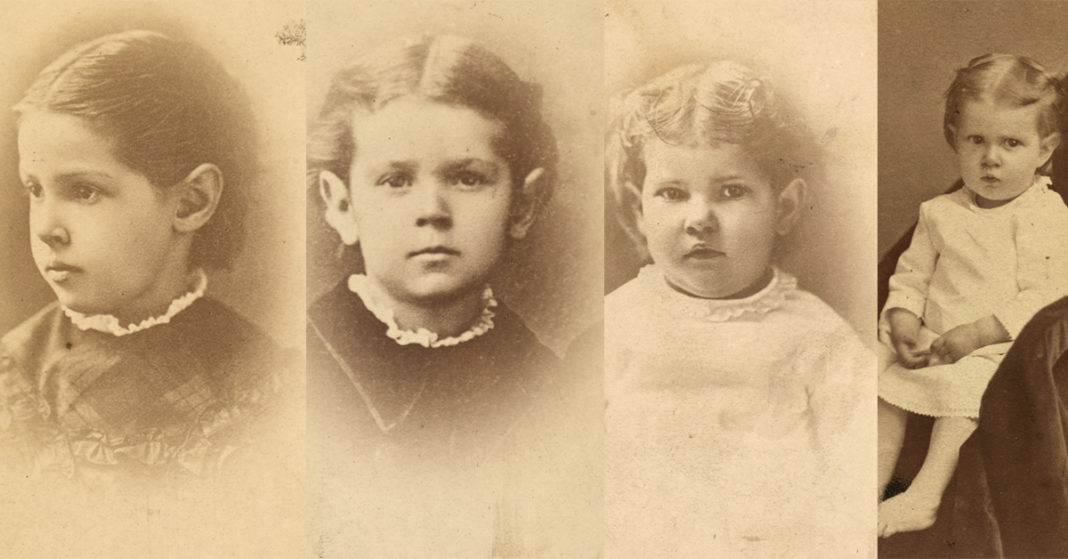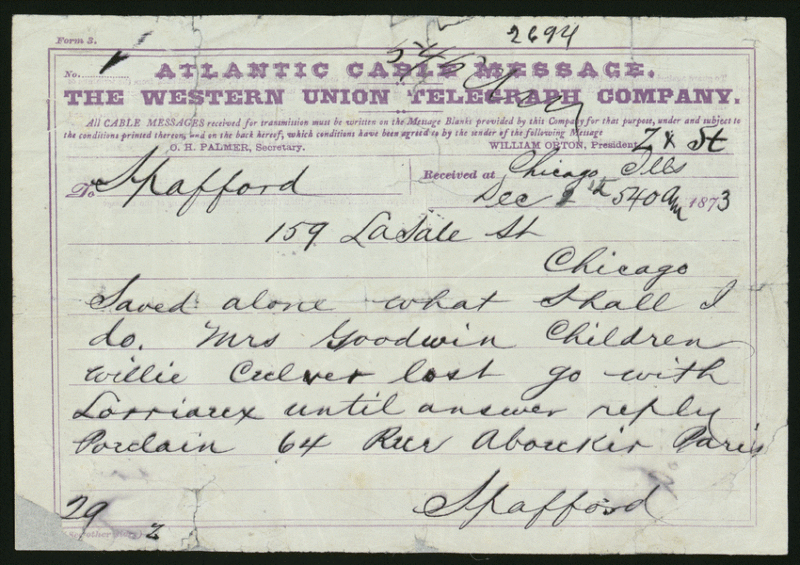Anna Spafford and The Story Behind the Telegram
The most popular hymn story of all time is that of Horatio Spafford and “It Is Well With My Soul.” Most hymn-lovers know of how Spafford received word that most of his family had perished in a terrible accident; how his wife Anna Spafford sent him the telegram “saved alone.” The story is always told from his point of view. After all, he is the writer of the hymn. Nevertheless, Horatio was not present at the disaster and did not live the horrific events. This is the tale of Anna Spafford and the story behind the telegram.
Young Anna Spafford Early Years
Anna Spafford was born Anne Tobine Larsen Øglende on March 16th 1842 in the ancient city of Stavanger, Norway. At the age of four, her father moved the family to a growing Scandinavian community in Chicago, USA. As a child, she was the only member of her family to remain unscathed by the Cholera epidemic that scourged the midwest in the 1840s. Her mother and younger brother, Hans, both died. After contracting the disease himself, her father retreated from Chicago to Minnesota to recuperate, taking young Anna along. Though he did recover, he soon relapsed and died, leaving Anna alone.
Back in Chicago, at the age of fifteen Anna enrolled in Dearborn Seminary. There she studied theology, mathematics, and the liberal arts. At this time she began to attend a community Sunday school class taught by a local, single lawyer named Horatio Spafford, fourteen years her senior.
Anna and Horatio soon developed a friendship that centered on their faith and mutual involvement in the Sunday school movement started by Horatio’s friend and famed evangelist, D.L. Moody. A year after meeting, Horatio proposed marriage, only to discover that Anna was sixteen. The relationship endured as Anna enrolled in a finishing school until she reached the legal marrying age of nineteen. On the September 5th 1861, Horatio, aged 33, and Anna, aged 19 finally married.
They enjoyed each other and had a happy marriage. In their bliss, they were joined by four daughters, born in quick succession, Annie, Maggie, Bessie and Tanetta. Blessed materially, Horatio was senior partner in a successful law firm, Spafford, McDaid, & Wilson. Their existence could be characterized as “elite”, as they lived in “Lake View”, one of Chicago’s most exclusive Victorian neighborhoods .
Great Chicago Fire
On October 8th, 1871 that charmed world came crashing down as the Great Chicago Fire tore through the city. Though the Spafford’s lived privileged lives, their commitment to ministry and serving others was put on display as Anna, (Horatio was out of town on business,) opened their home to the city as a shelter.
Though the home and family did survive, the disaster took its toll on Anna’s health, as well as the family finances. Preceding the fire, they had invested heavily in the Chicago real estate market. That investment along with 17,500 city buildings and 2000 square acres of development was turned to ash in only two days time.
Two years later, and still grappling with the financial repercussions of the fire, the family doctor recommended a trip to Europe to give Anna a chance to physically recover from an extended illness. Excited about the opportunity for his daughters, Horatio planned to make the trip an educational experience by taking the girls to museums and monuments.
Just as the family made plans to leave, a complication arose. The sale of their remaining real estate in Chicago fell through at the last minute, preventing Horatio from joining his family as planned. After discussing the matter, they decided together that Anna and the children would continue to France and await her husband there.
Spafford Family Onboard Ship
Anna Spafford and her four daughters departed New York harbor at 2 pm on November 15th 1873. Along with the Spaffords onboard the SS Ville du Havre were an additional 308 passengers and crew. Among them were five ministers returning to Europe. At the docks, the men made a promise to Horatio, who had accompanied his family to see them off, to look after his young family.

Once on board, eleven year old Annie quickly made friends with children her own age.
A little boy teased nine year old Maggie about all the ugly French children she would meet in Paris.
Seven year old Bessie was excited about the Sunday school class organized by one of the ministers.
The youngest, three year old Tanetta, quickly became the darling of the ship as she ran about the deck singing “In the Sweet By-and-Bye we shall meet on that beautiful shore!”
On the sixth night of the trip, midway across the Atlantic, Anna walked the deck of the ship with reverend Nathanael Weiss, after tucking her girls into bed. The 31 year old mother, who had already lost so much, stared over the railing into the dark water and commented, “it seems to me almost impossible that a ship can cross this immense ocean without danger. When I think that a few planks are all that separate us and all these charming people from the depths of the sea-“.
Shipwreck
About 2 am, the entirety of the ship was awakened by two thunderous booms. Startled awake and still confused, many passengers jumped out of bed and raced on deck to investigate the commotion. Captain Marino Surmonte assured the crowd that all was well. “We’ve been struck by a little ship, nothing to worry about,” he told them, not knowing that his ship had already begun to take on water.
The charge not to worry lasted only a moment. In just a few minutes the crew recognized that the ship had settled into the water. As word spread, panic ensued on deck as efforts to abandon the ship were hampered by the newly painted lifeboats that were stuck to the deck.
As only seconds passed, the ship rapidly began to break apart. The center mast collapsed on two of the lifeboats, killing several passengers and slightly injuring Anna’s arm. Finally, after chiseling and cutting at the dried paint, a few boats were yanked free as passengers fought to include themselves in the small number to be saved.
Three year old Tanetta quietly clasped the hand of reverend Weiss who had become a father figure over the past week. She looked up at him. “Pray for me,” she told him. He held her close, bowed his head, and quietly prayed “God have mercy on us all.”
After lifting up this quick prayer the three year old ran back to her mother’s arms, only to feel the deck give way under their feet as the ship broke in two and plunged into the water.
Into The Abyss
Reverend Weiss later described what happened next. “The hungry waves rush suddenly upon the after-deck, and in an instant everything is swallowed up in the yawning gulf…We feel ourselves whirled round and round as if in a vast funnel, and roll over in the depths of an abyss which seems immeasurable.”
Some passengers were in a state of shock, either from the unexpected fall into the cold sea, or because they were struck by the debris whirling around them. Some where hit so hard by pieces of the ship that they were killed instantly, leaving their bodies to float around the spinning cauldren.
Anna was hurled around the whirlpool. She felt Tanetta, whom she still clutched tightly, being ripped from her arms by the current. The young mother held onto her baby’s nightgown until a large piece of debris struck her already injured arm, causing her to lose her grip on the fabric. She watched as her three year old daughter disappeared helplessly into the vortex, just out of reach.
As Tanetta passed from sight, Anna was struck again, this time in the head, and knocked out. While unconscious, she was tossed out and away from the mass of the descending ship, and up to the calm surface.
Maggie and Bessie also emerged at the surface clinging to an American man. He fought the water bravely, attempting to save both girls by reaching a lifeboat. But whether by exhaustion or by injury, Bessie lost her grip on the man and slipped below the surface, not to reemerge. Just as the man reached the lifeboat, Maggie too, lost her grip and sank suddenly into the dark water.
Eleven year old Annie did not reappear. She was last seen on the deck of the ship as it broke apart and went under.
The Rescue of Anna Spafford
By this point, the Lochearn, the British iron sailing ship that had struck the Ville du Havre, turned to attempt rescue. Upon being pulled onto the deck, Anna, perhaps only aware of losing little Tanetta, searched in vain for her three older daughters, screaming out as she went. “They are lost! They are lost!” As reality of all four deaths set in, she ran to the rail, intent on joining them. Only the quick hand of reverend Weiss, who seized her before she could jump, kept the tragedy from being complete.
From the time of impact to total submersion, the Ville du Havre took only twelve minutes to break apart and sink. By morning, 81 persons had been saved. The remaining 226 were taken beneath the waves, including all four of Spafford’s daughters.
The crew of the Lochearn ran about distributing blankets, dry clothes, and hot beverages to survivors. The surviving members of the group of ministers attempted to console Anna, who, by this point was inconsolable and despondent.
Rev. Weiss turned to another surviving minister in attempt to gather more information. “How many of the children have been saved?”
“They all perished,” was the reply; perhaps surprised that Weiss still did not yet grasp the fullness of the tragedy.
“Oh!” Weiss cried. “If only I had kept little [Tanneta] with me, when she went over to her mother!”
After some minutes had passed, Anna began to calm herself, and think through her loss. She became more quiet, but still wept. “God gave me my four little daughters,” she said. “It is He who has taken them from me. He will make me understand and accept His will.”
After the Shipwreck
After the shipwreck, the Lochearn also was determined to be not seaworthy. The damage she had taken in the collision was deemed more severe than was oringally thought. The passengers and crew of both ships abandoned the Lochearn when another passing ship presented itself; in that case, a British vessel.
Once on dry land in England, Anna Spafford found a telegraph office and sent the now famous telegram to her husband in Chicago. “Saved alone. What shall I do?”
Today, Anna Spafford is held up as a woman who kept it all together under unimaginable circumstances. This is an unfair caricature as it minimizes the affects the event had on her psyche and faith. It is also an unfair standard by which to measure other mothers and faith in general.
Faith is built and grown in moments and circumstances in which we crumble to dust. I find it profound that Anna’s response to the deaths of her daughters was that the Lord “will make me understand and accept his will.” She did not pretend that she was resigned at that moment or even soon after. She did not hold herself together or console herself with platitudes.
She trusted that the Lord would provide solace, eventually. The only hope of seeing her daughters again and experiencing the mending of her torn soul at some point in the future, was in Jesus himself. This future hope of Anna Spafford is not blind belief or wishful thinking. It is, rather, a beautiful picture of faith that hurts.


